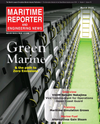
Page 31: of Maritime Reporter Magazine (March 2016)
Green Marine Technology
Read this page in Pdf, Flash or Html5 edition of March 2016 Maritime Reporter Magazine
of the assessor is removed. For instance, Captain Ted Morley, Chief Operations if a student should have turned a particu- Of? cer.
lar valve and didn’t, the computer would MPT’s S.M.A.R.T. campus was devel- record that. “We also use CCTV cameras oped to be a totally integrated simulation to see how they perform, so we’re able center with the ability for all of the simu- to record the events to be used during a lators to be involved in the same scenario de-brie? ng,” says Capt. McCarter. “The or operated independently. The three main software can also play the event back to simulator bridges are designed to emulate them. But in the end, when there’s an ex- the layouts found on modern passenger amination, a Transport Canada of? cial is ships, commercial vessels and offshore/ present to observe.” towing vessels. The consoles and equip-
BCIT’s marine campus has seven ment have been placed in locations that bridge simulators. The bridges can all be are identical to or close to how the bridges interconnected as necessary for particu- are laid out in real life. lar training exercises. Transport Canada The instructors and operators can adjust also sets the curriculum for deck of? cers. all manner of dif? culties. The system is
BCIT runs Simulated Electronic Navi- dynamic with respect to weather condi- gation (SEN) courses on a regular basis tions, sea state, visibility, steering, me- – training of? cers on how to understand chanical failures, ? re and ? ooding, ice and interpret radar, navigate safely and accretion and traf? c interface. Overall be- execute a passage correctly from point A haviour and utilization of resources is key to point B. in assessing students.
For example, in a SEN course, a re- “Technology is constantly improv- quirement could be that no ship will come ing,” says Capt. Morley. “MPT is very within one nautical mile of your vessel. If proud to have a dynamic and on-going a vessel comes closer than that, a trainee upgrade process that identi? es key areas will have to do the scenario again. Many of improvement and takes steps to inte-
SEN scenarios can be run in a variety of grate those enhancements. This is done environmental conditions from daytime on a six-month cycle wherein computers, with excellent visibility to foggy, restrict- graphics, cards, hardware interfaces, soft- ed visibility and night-time passages. ware, etc., are all evaluated and upgrad-
Depending on what level a mariner is at, ed. Improvements and additions to ship each will have different challenging exer- models and geographical areas are also cises to carry out. addressed. The goal is to make the train-
One of the bridge simulators simulates a ing environment as realistic as possible to tug with a 360o-degree capability. “More maximize the training value.” and more simulation centers are going MPT trains more than 12,000 mariners this route,” says Capt. McCarter. “This annually, and is currently expanding its one can interact with the other bridges, campus and simulation department. The too. For instance, we can run sessions total square footage is approximately whereby multiple tugs can be docking a 61,000 square feet. Enhancements are be- larger ship. So with that capability, you ing made to all components of the simu- can demonstrate how important com- lation department, including adding DP munication amongst the pilot, the ship’s capability to the full mission bridges and
Master, tug Masters and people on the new visual projection to all navigation dock is, for example, at the container ter- bridges. minals here in Vancouver Harbor.” BCIT “Simulation is a fantastic tool and while also has ECDIS, GMDSS and liquid car- it will never replace real-world experi- go simulators. ence, it does provide a measure of com- petence and task familiarity that is hard to
MPT duplicate,” says Capt. Morley. “We like to
The S.M.A.R.T. Campus at Fort Lau- say the only thing you bruise is your ego. derdale, Florida’s Maritime Professional The ability to test the limits of a vessel or
Training (MPT) features bridge simula- operator in varying weather conditions is tors, engine control room simulators, only really possible in a simulation.” liquid cargo simulators, as well as partial Capt. Morley sees virtual reality and task simulators such as six DP stations, global integration – using multiple simu- 12 ECDIS stations, 16 radar/arpa stations lation centers around the world connected and four all-weather stations. The main via the Internet to allow ship owners and simulator product used is Transas. “We operators to train with pilots or tug opera- also use real-world equipment includ- tors in far-ranging ports without having to ing Marine Technology DP, Furuno and bring them together in the same facility –
Sperry ARPA units, and Raytheon that as the two main areas that will require the the Transas software drives,” explains next generation of simulation technology.
MR #3 (26-33).indd 31 3/2/2016 10:52:27 AM

 30
30

 32
32
